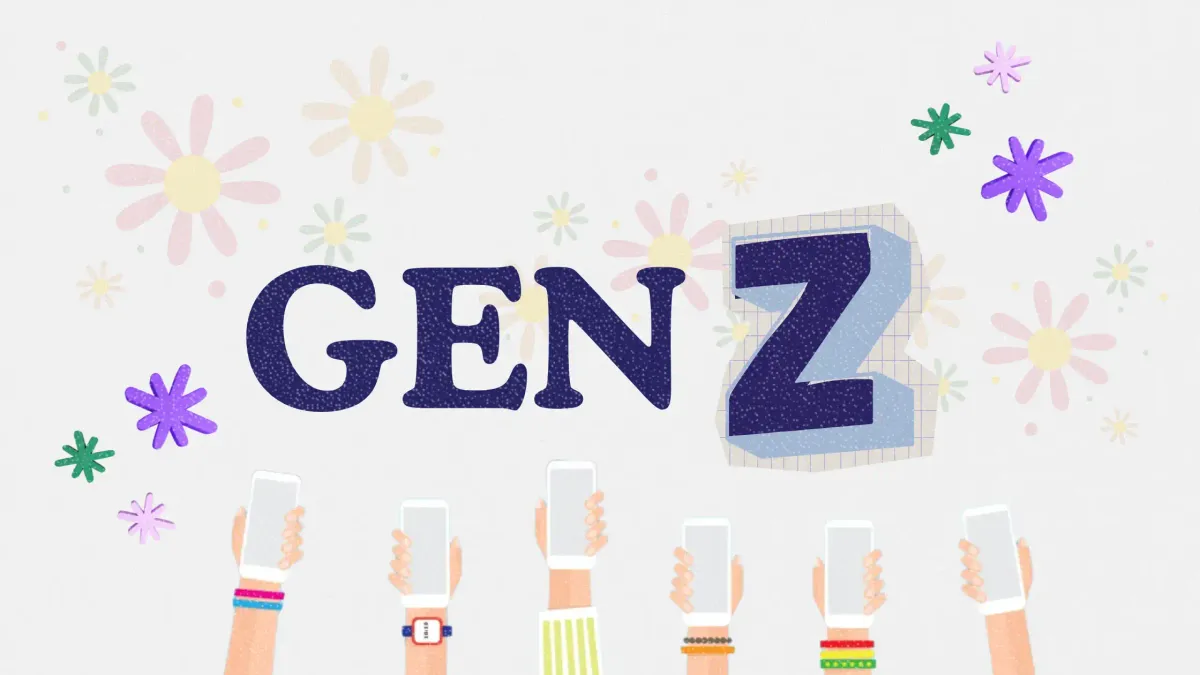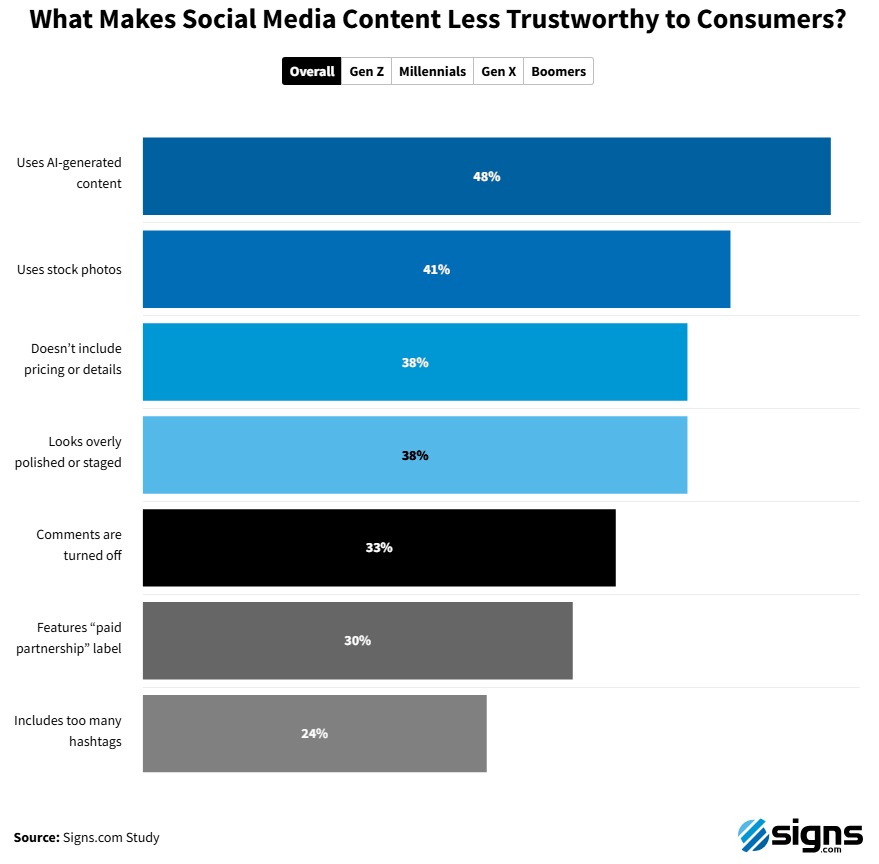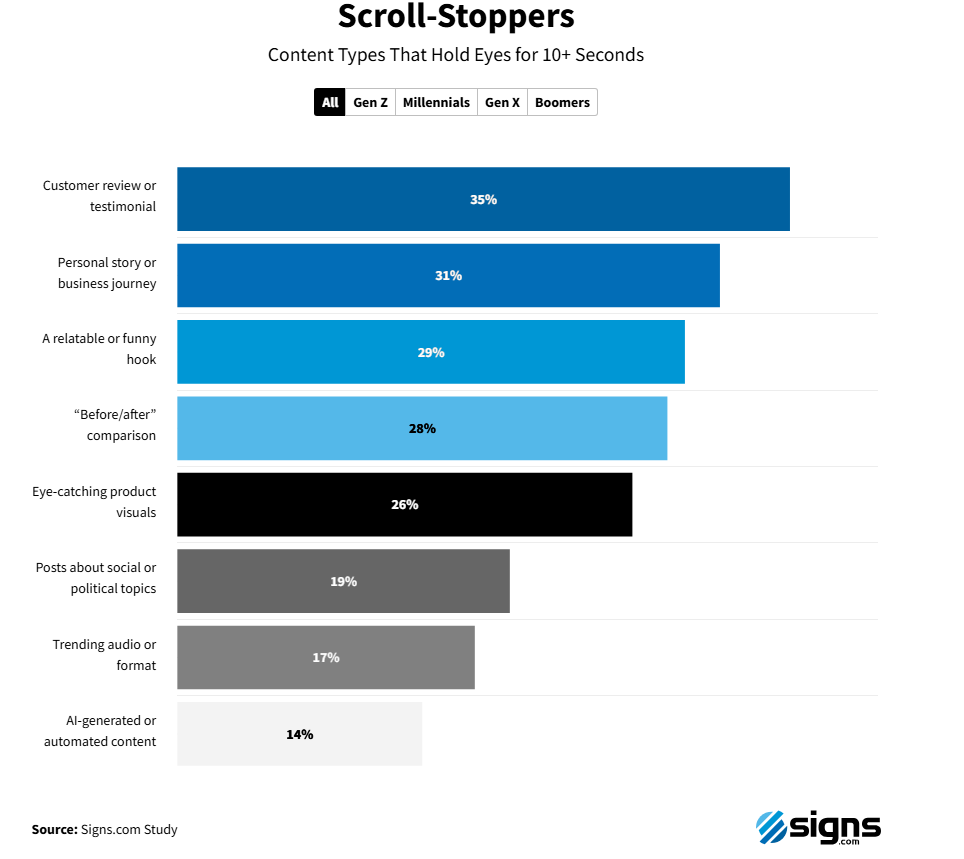How social media content really drives trust and sales for small businesses
Signs.com survey reveals where discovery, trust, and conversion actually happen on social

Social media isn’t just a brand awareness play anymore. It’s the new storefront for small businesses. A recent survey by Signs.com reveals how users really interact with business content online and what makes them trust, stop scrolling, or hit the buy button.
Whether you're leading B2B content strategy or managing multi-brand accounts, these insights can sharpen how you approach social media in a time of short attention spans and rising AI skepticism.
This article explores key findings from a 1,000-person U.S. survey, highlighting which platforms work best for discovery, what content builds credibility, and which formats drive actual purchases.
Short on time?
Here’s a table of contents for quick access:
- Where discovery happens: platform breakdown by generation
- Trust signals vs red flags: what users respond to
- The content formats that stop scrolling
- What actually drives conversion on social

Where discovery happens: platform breakdown by generation
According to the data, Facebook is still leading for small business discovery — at least overall. 61% of respondents said they found a small business there in the past six months. But break it down by age group and things shift fast.
- Gen Z prefers TikTok (76%) and Instagram (70%) for discovering small businesses
- Millennials also favor Facebook (69%), Instagram (54%) and YouTube (53%)
- Gen X and boomers rely more on Facebook
- Reddit, while lower overall, still captured 27% of Gen Z for discovery

For marketers, this reinforces the need for platform-specific strategies. Older demographics may still be reachable via Facebook and YouTube, but younger consumers are clearly spending more time on TikTok and Instagram.
Trust signals vs red flags: what users respond to
So what kind of content builds trust?
- User-generated content (UGC) ranked highest overall at 31%
- Brand-created visuals (27%) and influencer shoutouts (20%) followed
- Gen Z trusts influencer content more (30%) than any other group
- Boomers and Gen X lean heavily on UGC and customer reviews

On the flip side, AI-generated content is a trust-breaker, especially among younger users. Nearly half (48%) said AI posts make them trust a business less, with 64% of Gen Z flagging it as a concern. Other red flags include:
- Stock photos (41%)
- Missing product details or pricing (38%)
- Overly polished visuals (38%)

In short, authenticity beats automation when it comes to building social credibility.

The content formats that stop scrolling
With 49% of users spending 10 seconds or less on a post before scrolling, the challenge is real. But some formats consistently hold attention:
- Customer testimonials (35%)
- Personal stories (31%)
- Funny or relatable hooks (29%)
- Before-and-after visuals (28%)

Gen Z showed strong engagement with humorous and trend-based content, while older audiences preferred informative formats like before-and-afters and testimonials.
The least engaging? AI-generated content (29%), political posts (22%), and trend-only videos (19%). Attention spans are short, but relevant content still wins.
What actually drives conversion on social
Some formats do more than just grab attention — they convert.
- Customer reviews and testimonials topped the list at 52%
- Product demos or tutorials followed at 43%
- Trend content like “TikTok made me buy it” influenced 30% of Gen Z
- Millennials favored customer reviews (52%) and giveaways (28%)
Boomers and Gen X responded best to product demos and behind-the-scenes content. Regardless of age, content that provides clarity and proof continues to perform.

What marketers should know
Here’s how marketers can act on this data:
1. Match platform to audience
Gen Z and millennials live on TikTok and Instagram. Older audiences stick to Facebook and YouTube. Build your content strategy accordingly.
2. Use UGC and testimonials to build trust
People trust people. Incorporate UGC, reviews, and real customer voices into your organic and paid content.
3. Avoid overusing AI
AI-generated content may be efficient, but it undermines trust — especially with younger audiences. Prioritize a human-first strategy.

4. Grab attention quickly
Lead with emotion, humor, or a compelling visual. Optimize content for mobile-first behavior and rapid scroll speeds.
5. Lean into conversion-ready formats
Product demos, before-and-after visuals, and testimonials consistently perform. Use these mid-funnel to drive purchase decisions.
While social algorithms and tools evolve rapidly, what makes people engage and buy remains the same: trust, relevance, and clarity. Small businesses and marketers who align platform strategies with real user behavior can drive stronger engagement and conversion — without resorting to gimmicks or generic AI fluff.
What matters most is staying true to your audience. And in 2025, that means balancing authenticity with speed, and strategy with substance.






